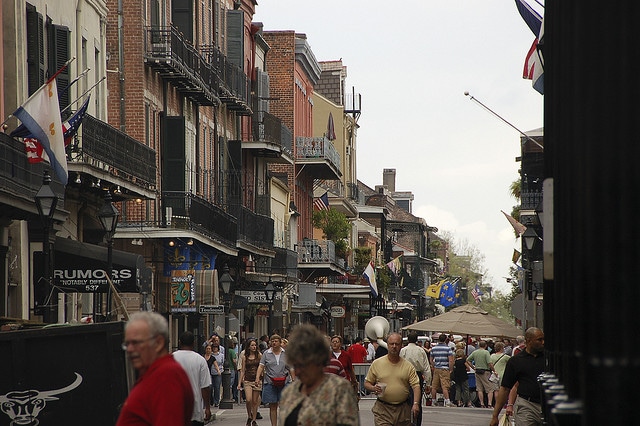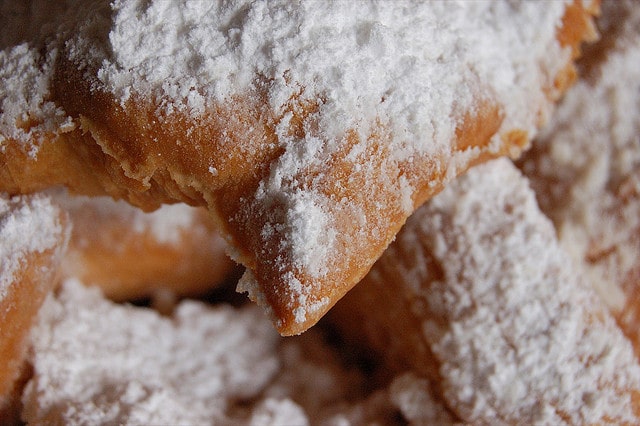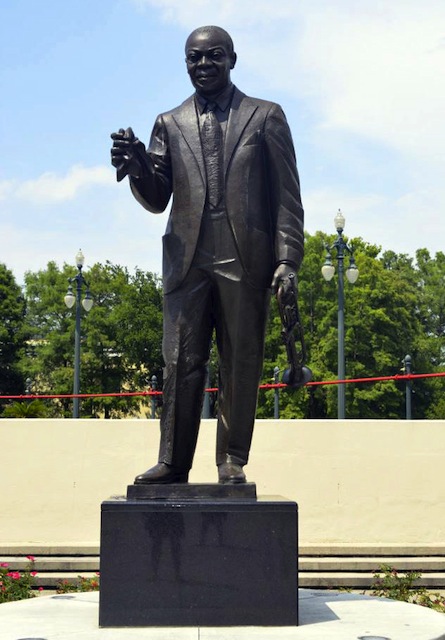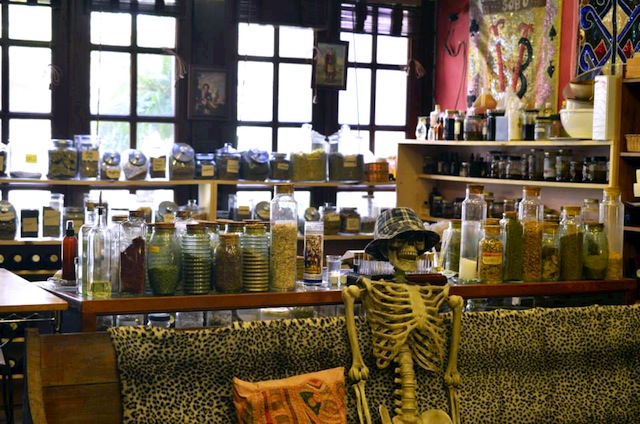
For those wanting to experience culture in New Orleans, you’ll have many opportunities. The city’s culture is complex. It’s not just about the Creole food or the rich jazz heritage, but a blending of interesting facets that come together to create a destination unlike any other in the United States. To help you plan an immersive itinerary, here is your guide to cultural experiences in New Orleans.
French Heritage
Although a city in Louisiana, New Orleans was actually founded by the French. Inhabited by Native Americans in the beginning, the city became part of an important trade route when these people created a portage between the headwaters of Bayou St. John and the Mississippi River. French explorers and traders began building settlements along the bayou, and in 1718 New Orleans, then called Nouvelle-Orléans, was founded by the French.
Although the French no longer rule New Orleans, the city’s French heritage can still be explored. Interestingly, the architecture of the French Quarter is mainly Second Generation Creole and Greek Revival styles. That being said, a visit to the Ursuline Convent allows you to see the last authentic in-tact building designed before the city’s transfer of power to the Spanish. Moreover, you can see a few French-style buildings around Chartres Street. And even when looking at the other architectural styles in NOLA you can see French influence. For example, typical Creole Cottages exhibit some French building styles as these types of structures evolved from French and Spanish architecture.
Kayaking Bayou St. John with Kayak-Iti-Yat on their Big Easy Bayou Tour also allows you to explore New Orleans French heritage, as you’ll, in essence, travel through history exploring the original trade route and learning about the bayou’s significance from a knowledgeable guide. Historic buildings, wildlife and diverse New Orleans neighborhoods are also park of the experience.
Another great touring option for discovering New Orleans’ French heritage is taking a Segway tour with City Segway Tours New Orleans. Not only does it provide a different, more unusual way of seeing the city, but guides are knowledgeable and fun. Moreover, a variety of tours are offered, including a Private Segway Experience where you can inform the guide about your interest in the city’s French heritage.
And of course, visitors can explore New Orleans’ French heritage through the plethora of French restaurants. For a truly historic experience, head to Antoine’s Restaurant (713 Saint Louis Street).
Serving authentic French-Creole dishes, the restaurant is the oldest restaurant in New Orleans and has been open since 1840. Make sure to sample some of their invented creations like the Oysters Rockefeller, oysters on a half-shell topped with herbs, butter and breadcrumbs and baked; Pommes de Terre Souffles, which are like puffed French fry pillows; and Eggs Sardou, poached eggs topped with artichoke hearts, ham, anchovies, truffles and hollandaise sauce named after famous French dramatist Victorien Sardou.
Other notable dishes include fried oysters on toast buttered with paté de foie gras and served with a rich Colbert sauce; a filet of speckled trout with toasted sliced almonds and lemon butter sauce; and a chicken breast served with a Rochambeau sauce and a rich Béarnaise over a slice of baked ham. A few other great French restaurants in New Orleans include La Provence, Restaurant August and Herbsaint.

Sausage and shrimp jambalaya. Photo courtesy of gromgull.
Louisiana Creole Dishes
Everywhere you turn in New Orleans you’ll be able to sample tasty Creole cuisine. This type of food tends to take classical European styles of cooking and incorporate local foods and ingredients. While the Spanish, Italian and Canarian introduced spicy peppers, citrus-based marinades, rice and beans, the African introduced slow cooking and the idea of extracting and preserving as much flavor as possible. Some typical Creole dishes you’ll likely see in New Orleans include gumbo, Oysters Bienville, blackened salmon, Crawfish étouffée and red beans with rice.
For a truly immersive Creole dining experience, Arnaud’s (813 Bienville Avenue) has been serving authentic Creole since 1918. Their focus is on tradition, which is apparent in their turn-of-the-century dining rooms.
After enjoying a handcrafted cocktail in their 1920s-reminiscent French 75, head over the main dining room (or one of the other dining rooms, as Arnaud’s has 14 in total) to sample traditional Creole fare. Some dish recommendations include the Shrimp Arnaude, Gulf Shrimp marinated in a tangy Creole Remoulade Sauce which has been on the menu since 1918; Oysters Bienville, which were invented by Arnaud’s and feature shrimp, mushrooms, green onions, herbs and seasonings in a white wine sauce; and the Ponchartrain, a hearty fish fillet topped with Louisiana crab meat.
A few other great Creole restaurants in New Orleans include Commander’s Palace, Jacques-Imo’s Cafe and, for an authentic Creole meal aboard a historical boat, Steamboat Natchez.
Cajun Food Fare
The ingredients found in Cajun cuisine aren’t all that different from Creole. The main difference is the preparation and philosophy, as Cajun cuisine is thought to be more rustic and simple, created with local ingredients. Dishes are usually cooked using three pots: One for the main course; one for steamed rice, sausages or seafood; and one for vegetables. Expect lots of ground cayenne and fresh black pepper. Some typical Cajun dishes you’re likely to find in New Orleans include a special pork called boudin made from pork, pork liver, rice, garlic, green onions, and other spices; gumbo; jambalaya; rice and gravy; boiled crawfish; brochette.
For the best Cajun dining experience in New Orleans, head to Mulate’s (201 Julia Street). Here you’ll taste authentic Cajun dishes while enjoying traditional Cajun music and dance. The eatery does a great job of preserving the Cajun culture and traditions of the small towns littered along southern Louisiana’s bayous, with a menu featuring dishes like Cajun smoked oysters, grilled or fried alligator, seafood gumbo and grilled catfish. Some other traditional Cajun restaurants in New Orleans include New Orleans Food and Spirits, Cochon and Charters House Cafe.

Beignets at Cafe Du Monde. Photo courtesy of clamhead.
Local Delicacies
Along with having a few dominant local cuisines New Orleans is home to some delicacies, which can help you learn about the local culture. Start by sampling some beignets at Cafe du Monde (800 Decatur Street), a traditional al fresco cafe open 24/7 that serves only drinks and beignets. Beignets are square French-style doughnuts generously topped with sweet powdered sugar.
Another must-try item when in New Orleans is pralines. No matter where you are — but especially down Decatur Street – you’ll find numerous shops selling pecans coated in brown sugar and creme, sweetened or spiced. Many of these shops offer free samples, and if they don’t it doesn’t hurt to ask for some.
And for something savory, Gulf oysters on the half shell feature local oysters served raw in the shell and are a local staple. For a unique spin on the dish, head to Bourbon House (144 Bourbon Street) to have them topped with local caviar from New Orleans-based Cajun Caviar.

The Cochon with Mustard Greens lunch plate served with fried green tomatoes and spicy Remoulade at EAT New Orleans.
Farm-to-Table Restaurants
One dominant part of New Orleans’ culture is the importance put on using locally-sourced, fresh ingredients. And because the standard for quality is extremely high in New Orleans, you can expect quality, sustainable ingredients in both budget-friendly eateries and fine dining establishments.
When visiting New Orleans, I was lucky enough to enjoy my very first dining experience at EAT New Orleans (900 Dumaine Street). The farm-to-table eatery has a rustic feel, with simple Magnolia-adorned white clothed tables, lots of natural sunlight and walls featuring rotating local artwork. The menu focuses on classic Creole and Cajun dishes made with locally-sourced ingredients. Everything on the menu is made from scratch except for the bread, and even that features a unique twist as the eatery is possibly the only restaurant in New Orleans to grill their French bread. The goal of the restaurant is to help support the local farmers and fishers, while also providing a casual ambiance and quality dishes for restaurant patrons. Begin your farm-to-table experience with an appetizer of homemade Crawfish Boullettes, which are like seafood hush puppies. These hearty, savory balls of flavorful goodness feature crawfish, breadcrumb stuffing and seasoning, and are served with a spicy Remoulade sauce made without mayo. For your entree try the Cochon with Mustard Greens lunch plate. The Cochon features slow-cooked pork squares with crispy outsides and pull-apart insides, served over mustard greens that are cooked in chicken stock to take out the bitterness. And don’t leave without sampling one of their homemade desserts, especially if Banana Cream Pie is on the menu. The dessert is extremely rich, with a crumbly crust and fresh banana slices hidden under the creamy pie. Fresh strawberries and blueberries drizzled with sweet ganache are served on the side.
Another great farm-to-table experience right on Bourbon Street is Bourbon House (144 Bourbon Street). About 70% of their food comes from within 150 miles, which is something the restaurant strives for when choosing their ingredients. Moreover, the only thing they don’t make in-house is the bread, which is purchased locally at Leidenheimer. Because they’re known for having the best oyster shucker in town — he holds the official title — guests should sample their oysters topped with local caviar or their Trio of Oysters to try them in a number of different styles. Crab-crusted fish, roast chicken with jambalaya risotto and shrimp Creole over Louisiana popcorn rice are other top menu choices. And, as the restaurant is known for their extensive bourbon selection with over 100 bourbons, adding a flight or bourbon cocktail to your meal completes the experience.
Craft Cocktails
Some believe cocktails were invented in New Orleans, specifically with the birth of Sazerac in the early 1800s. While cocktail standards started to decline in the 1970s due to people wanting things cheaper and quicker, New Orleans stayed true to its classic cocktail roots and has been creating high-quality drinks for over 200 years. Because of this, you’ll find numerous establishments offering craft cocktails. Start your “spirited” journey by going back in time at French 75 (813 Bienville Street). Once a gentlemen-only club, the sophisticated French Quarter establishment takes you back in time to the old school bars of the early 18th century, with monkey lamps, dark varnished woods, a vintage bar, low tables and settees and tiled floors. The establishment is named after the classic French 75 cocktail, crafted with Courvoisier VS, sugar, lemon juice, Moet and Chandon for a drink combing the light, uplifting bubbles of Champagne and the rich flavors and warmth of brandy. If you want something personalized, you can tell head bartender Chris Hannah or one of the other skilled mixologists what types of flavors you enjoy for a well-balanced drink suited to your tastes. Some other cocktails on their menu include the “Lillet Cobbler” with Lillet, Creme de Mure and lime juice; “The Baroness” with Boobles gin, Aperol, Ruby Red grapefruit juice, Rhubarb Cordial and Orange Bitters; and “La Louisiane” with rye whiskey, vermouth, Benedictine, Herbsaint, Angostura and Peychaud Bitters.
Another worthwhile option for those wanting to explore New Orleans’ craft cocktail culture is Cure (4905 Freret Street). Reminiscent of a time when cocktails grew from home remedies, Cure offers a sophisticated venue for cultured discussion and quality drinks. The dimly lit renovated firehouse features a impressive bar shelved with quality spirits, as well as round tables illuminated by candlelight. Sample my personal favorite, their “White Witch,” crafted with Cocchi Americano, Barsol Primero Pisco, Strega and Witch Bitters; the “Ms. Camille” featuring Evan Williams Single Barrel Bourbon, Marolo “Milla” Chamomile Liqueur, sparkling wine, honey and lemon; or an “Escana Cao” featuring Rare Wine Charleston Sercial Madeira, Germain Robin Craft Method American Brandy, Peychaud’s Bitters and orange peel.
And for a farm-to-bar craft cocktail experience, The Three Muses (536 Frenchmen Street) serves thoughtful drinks made with local and housemade ingredients, for example, their ginger beer, cherry cola, bitters, olive brine and fruit juices. In a contemporary country atmosphere sip a “Luisas Husky Revenge” made with Zaya rum, housemade ginger beer and basil-lemongrass bitters; “Suspiciously Absinthe” with Toulouse Red Absinthe, housemade grapefruit-dill bitters and hibiscus grapefruit soda; or a ”Tequila Tiff” concocted with Avion Reposado with Agave Nectar, fresh squeezed grapefruit juice and soda. Their spin on the classic “Sazerac” is also a great option, featuring house-infused vanilla Sazerac rye whiskey, Cointreau and housemade orange-fennel seed bitters. Leave pretension at the door, as this place is all about quality drinks, delicious tapas, live jazz music and having fun.
Those interested in exploring New Orleans’ craft cocktail scene should also visit the Museum of the American Cocktail (currently housed in the Southern Food and Beverage Museum until mid-2013 when it will open in its new location at 1504 Oretha Castle Haley Boulevard). The museum features informative cocktail exhibits and drink history displays and puts on lectures and workshops for those who want to learn more about cocktail making as an art.

Statue of Louis Armstrong Park in the Tremé neighborhood of New Orleans
Jazz Music
New Orleans is the birthplace of Jazz music, specifically Louis Armstrong Park’s Congo Square, a historic meeting place for slaves to make music in the 1800s. The park is a great place to begin your exploration of New Orleans’ Jazz culture. Sit in on a drum circle in Congo Square, admire the beautiful jazz-inspired public art and monuments (especially the sculpture of Louis Armstrong himself), check out the jazz exhibit in Perseverance Hall, see a show at the Mahalia Jackson Center for the Performing Arts or just stroll along the grassy knolls and lagoons.
Another great way to experience New Orleans’ jazz culture is by taking in a live jazz performance. There are numerous venues throughout the city offering free live jazz shows (often there is a one drink minimum). Take a walk down Frenchmen Street around 8pm — although you may want to go earlier to secure a seat –and you’ll come across numerous jazz venues like the Spotted Cat, the Three Muses and Blue Nile. On Bourbon Street, amongst the craziness of flying beads and vodka-filled solo cups, you can seek refuge at the sophisticated Irvin Mayfield’s Jazz Playhouse in the Sonesta Hotel (300 Bourbon Street) each night at 8pm, which is when the jazz performances start. The venue is also known for their craft cocktails and tasty bar bites.

Inside one of the many voodoo shops in New Orleans.
Voodoo Culture
One interesting facet of New Orleans culture is the voodoo influence. This stems from 1719, when slaves were brought over to Louisiana from Africa. These slaves were unwilling to part with their gris gris, or magic-making, objects, and used Africa healers to cure their ailments. And because neither French nor Spanish regimes attempted to suppress this part of their culture, it has been able to continue until today.
Make a stop into the New Orleans Historic Voodoo Museum (714 Dumaine), where you can take in informational exhibits, voodoo artifacts, alters, statues, dolls and other interesting objects. You’ll leave having a deeper understanding of the culture and history. Moreover, a few doors down you can also visit one of the many voodoo shops in New Orleans, filled with potions, herbs, statues and oils that are supposed to help change your life. You can even request to have your own special blend of herbs made up based on what you’re trying to achieve.
To explore New Orleans’ voodoo culture in a luxurious way, head to the Ritz-Carlton, New Orleans Spa (921 Canal Street) for a “Voodoo Love Bath and Massage” treatment. The 70-minute experience is a spellbinding experience that incorporates the earthy oil Marie Laveau, the most powerful Voodoo queen in the world, gave to her clients. While you steep yourself in the warm waters incense fills the room while red candles flicker and voodoo music enhances the ambiance. This is followed by a Swedish massage.
Art
While one could write a book about the art offerings of New Orleans, there are a few experiences one must have when exploring the creative side of New Orleans. First of all, open-air art markets abound. While in the Uptown/Garden District you can head to Palmer Park on the last Saturday of every month, the Freret Market in the same neighborhood occurs on the first Saturday of each month. Around Jackson Square in the French Quarter you’ll find painters and street performers on the car-less roads, making you feel like you’ve been transported to Europe. And don’t miss the waterfront French Market, filled with everything from paintings to handicrafts to clothes to traditional foods.
If you’re interested in a gallery experience, stroll down Royal Street and Magazine Street in the Warehouse District. And don’t leave NOLA without visiting some of the city’s vibrant art museums, some of which include the Besthoff Sculpture Garden, Contemporary Arts Center, Diboll Gallery at Loyola University, George and Leah McKenna Museum of African American Art, the New Orleans Museum of Art and the New Orleans African American Museum, to name a few.
Bayou Experiences
And of course, Louisiana is well-known for its bayou experiences. As mentioned above, kayaking Bayous St. John with Kayak-Iti-Yat on their Big Easy Bayou Tour also allows you to explore New Orleans history, bird-watching, neighborhoods and landscapes with a knowledgeable guide. This is a great tour for those who want an informative and active bayou experience. For something more tailored to adventure-seekers, a swamp tour allows you to learn about local flora and fauna as well as hold and pet live alligators.
French Quarter in New Orleans. Top Photo courtesy of gnalnad.

Jessica Festa is the editor of the travel sites Jessie on a Journey (http://jessieonajourney.com) and Epicure & Culture (http://epicureandculture.com). Along with blogging at We Blog The World, her byline has appeared in publications like Huffington Post, Gadling, Fodor’s, Travel + Escape, Matador, Viator, The Culture-Ist and many others. After getting her BA/MA in Communication from the State University of New York at Albany, she realized she wasn’t really to stop backpacking and made travel her full time job. Some of her most memorable experiences include studying abroad in Sydney, teaching English in Thailand, doing orphanage work in Ghana, hiking her way through South America and traveling solo through Europe. She has a passion for backpacking, adventure, hiking, wine and getting off the beaten path.








